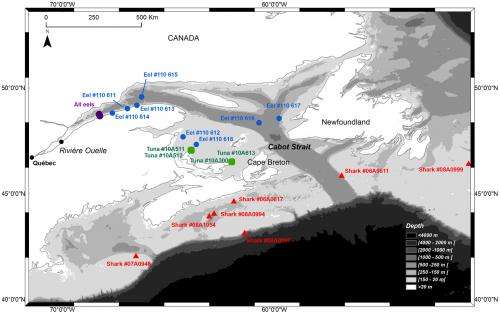Eel migration study reveals porbeagle shark predation in the Gulf of St. Lawrence

A tagging study has revealed that porbeagle sharks in the Gulf of St. Lawrence could severely impact the number of migrating American eels in the region.
Canadian researchers tagged eight adult eels in the St. Lawrence River as part of the Ocean Tracking Network's investigation to uncover the eels' pathway through the Gulf to spawning grounds in the Sargasso Sea— a journey that has mystified scientists for over a century.
Adult eels have never been seen in the Sargasso Sea. The researchers hoped to track their eels right into the Sea to precisely document spawning areas. Eight eels from the St. Lawrence River in Quebec were tagged with satellite "pop-up tags." All eight tags detached from the eels and surfaced prematurely, suggesting the eels' untimely death.
Seven tags transmitted data which included swimming depths, times, dates, and sea temperatures. Six tags recorded a sharp and sustained spike in temperature. Water temperatures in the Gulf of St. Lawrence in October range between 0 - 10°C. Tags recorded temperatures of 22 - 28°C—stomach temperatures of warm-bodied pelagic fishes.
The ingested tags continued to record data on the dive patterns and depths of the animal. By comparing the known diving and depth patterns of porbeagle sharks and bluefin tuna to those recorded by the tags, investigators identified porbeagle sharks as the predators.
On March 11, the Convention on International Trade in Endangered Species voted for greater protection of five shark species including porbeagle sharks.
Julian Dodson, professor at Laval University and OTN principal investigator, coauthored the study. "Both species are in trouble, and measures to conserve one may well be at odds with efforts to protect the other. What we really need now are studies to quantify just how important eels are in the diets of sharks and just what impact shark predation has on eel abundance."
In addition to pop-up tags, investigators also fitted an additional 113 eels with acoustic tags. These simpler tags broadcast only their identity and are detected by receivers moored in the ocean. Only four of the 113 eels leaving the Gulf of St. Lawrence for the Atlantic Ocean were detected on the OTN acoustic array in the Cabot Strait. The information suggests that the porbeagle sharks are taking a heavy toll on the migrating eels.
"We could hope that there will be increased pressure to protect eels in fresh water, particularly during downstream migration through power dams," says Mélanie Beguer-Pon, OTN researcher at Laval University. "We can't do anything about shark predation, but we can limit mortality in turbines."
More information: www.plosone.org/article/info%3Adoi%2F10.1371%2Fjournal.pone.0046830
Provided by Dalhousie University

















